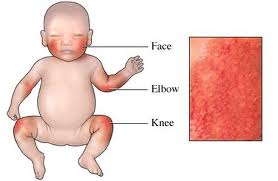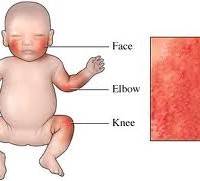Before looking for solutions on how to treat baby eczema, you should know that it is associated to the immune system’s reaction to irritants and the altered epidermal barrier function.
The physical impact depends on the severity of the disease and can range from annoying dryness to severe itchy skin with painful cracking, weeping and secondary infection.
Studies suggest 60-90% of children suffer from sleep disturbance, secondary to the severe pruritus associated with the disease.
Irritability and lack of concentration can lead to detrimental effects in schooling, educational development and social interactions. The stress of caring for a child with eczema can have profound effects on all family members, especially for mothers of severely affected children.
How to treat baby eczema – identify and avoid triggers
The main steps in treating baby atopic dermatitis are: avoidance of irritants and proven allergens, hydration and moisturization as well as topical anti-inflammatory therapy. Education of patients and care givers for children is crucial in the successful management of atopic dermatitis. Having a realistic understanding of the course of the disease and exacerbating factors is important in dealing with a chronic, relapsing illness.
The following are other common eczema triggers:
1. Weather. Baby eczema is linked to seasonality with the majority of patients with established eczema reporting deterioration in winter months and improvement in summer. Exposure to mild sunlight helps clear the skin, while strong winds and humidity aggravate the condition.
2. Irritants. Even when eczema has been controlled, it can get uncontrolled when exposed to triggers. But when eczema is already afflicting you, then you are exposed to irritants, you may be seeing the worse symptoms. Common irritants include:
-
- Dust
- Types of fabric particularly nylon and wool
- Overheat
- Super cold dry weather
- Detergents and soaps, shampoos, bubble bath, and laundry soaps.
3. Environment. The environment itself can trigger eczema. Those who are born with parents having atopic dermatitis will develop eczema when they are exposed to irritants like:
- Pet fur
- Dust mites
- Pollen

How to treat baby eczema
4. Food allergens. Even the food, too, can cause eczema. Babies aged one year and above are more likely to have atopic dermatitis when they have eaten foods which they are allergic to. A few food allergens are:
- Wheat
- Cow’s milk
- Soya
- Eggs
- Nuts
How to treat baby – preventive actions
Because eczema is largely caused by genes, the best cure is prevention. Below are a few tips on how to help eczema:
1. Diet. Change of diet may be a must especially for children. Many parents switched on to organic and unprocessed foods to avoid food allergens.
2. Use mild hypoallergenic soap. Many bath soaps contain ingredients that may harm the skin. But hypoallergenic soaps are less likely to cause allergic reactions because they do not have ingredients which may otherwise cause allergies. Baby soaps are mostly hypoallergenic.
3. Hydrate and moisturize skin. To avoid dryness, the skin needs to be rehydrated and moisturized. To lock in the moisture, apply moisturizing oils onto your children’s body after bath before drying up with a towel. There are a few choices for topical creams. There are products that do not need prescriptions like hydrocortisone 1 per cent, or prescription creams such as having corticosteroids which can relieve inflammation. When eczema is worsening, oral corticosteroids may also be prescribed by your physician.
Now, also have a look at Why does your toddler develop eczema and how can baby eczema cream come in handy?
